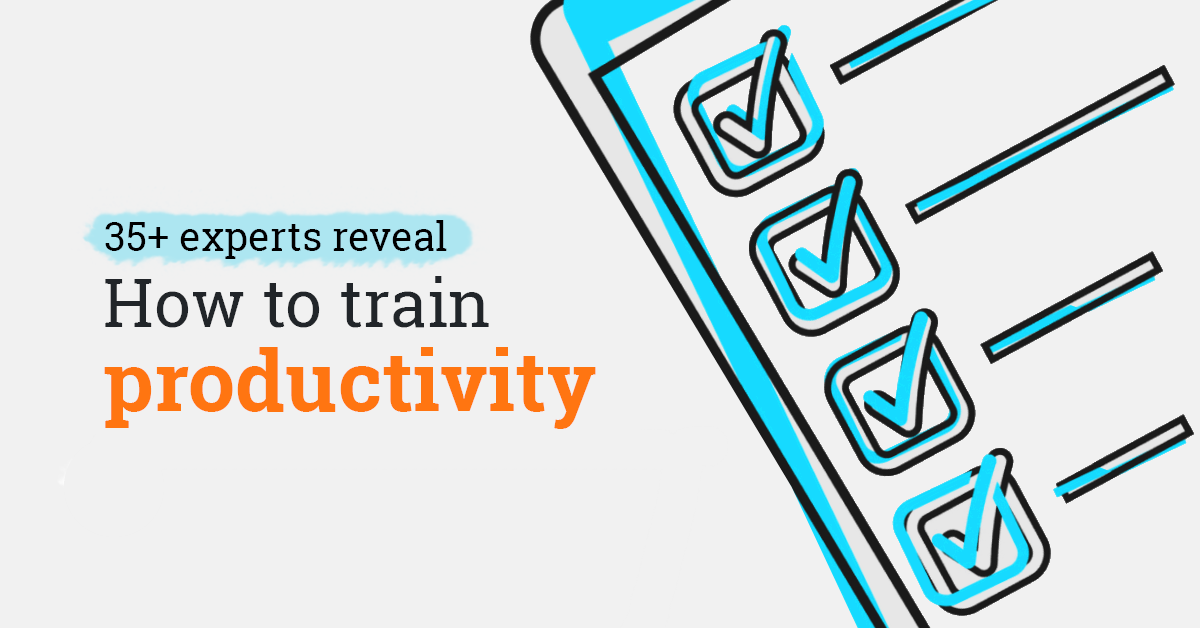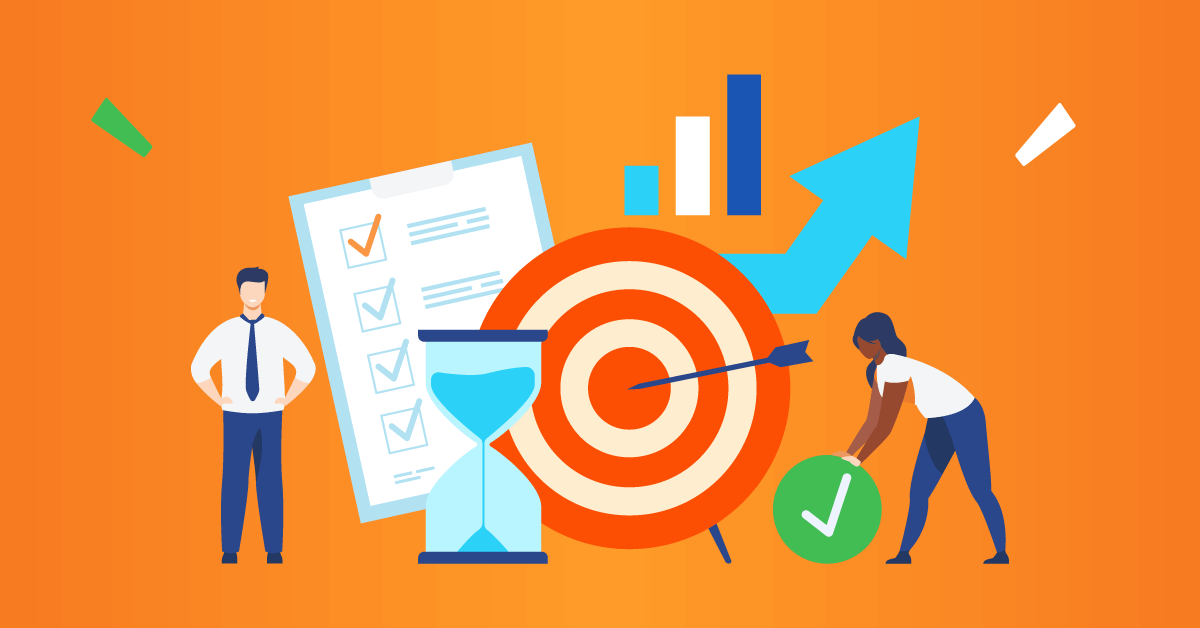- Tip #1: Productivity training starts by creating new habits
- Tip #2: Create a productivity system from scratch
- Tip #3: Create a tailor-made productivity program
- Tip #4: Workforce productivity and the power of pen and paper
- Tip #5: Know how time is spent
- Tip #6: Train your team on productivity tools
- Tip #7: Explore several methods to deliver your productivity training
- Tip #8: Start your day by actually working
- Tip #9: Don’t completely rely on your brain
- Tip #10: Improve cross-team communication
- Tip #11: Reduce meetings
- Tip #12: Maintain a distraction-free environment
- Tip #13: Work remotely
- Tip #14: Write smart
- Tip #15: Do weekly reviews
- Conclusion: Yes, productivity at work is a matter of training
We asked 37 productivity experts a simple question: can employee productivity be trained? 36 said yes. But how exactly do you train people on productivity?
As everybody seems to be talking about workplace productivity these days, we wanted to explore how experts in the matter believe it can be trained. However, the concept of productivity training is not new. Companies have always been looking for ways to maintain productivity in the workplace through many different means, such as team building and fun activities. And for some time, it worked. Employees felt happier at work. As a result, workplace efficiency increased.
But in the mid-1990s, something big happened and changed the way people worked. The World Wide Web — aka, the Internet.
In 2018, a study found that 55% of people never turn their phones off. At the same time, people tend to check their phones every 12 minutes during their waking hours. So, in a distraction-full era where our attention is constantly bombarded by notification sounds and lit lock screens, the ways to increase productivity in the workplace become less obvious. And our to-do lists turn to to-don’t-care lists.
But employee training on productivity at work, according to experts, can change that. If you’re looking for tips on how to boost and train productivity at work, you’ve come to the right place. Here is your 15-tip employee productivity formula.

Tip #1: Productivity training starts by creating new habits
You might have purchased the right tools an employee needs to use every day. But to train employees on productivity, you need to start from the bottom — just like with any type of training at work. So, don’t just wait for motivation to magically appear. Create habits.
Fadeke Adegbuyi is the marketing manager at Doist, a company that has created top-rated productivity apps to help people and businesses work more efficiently. She believes that the very first step towards productivity training at work is action:
“If we waited for motivation to strike before taking action, most of us would get nothing done. Instead, it’s important to create daily habits and cultivate conditions that will help you get more done. Have a regular routine that makes space for deep work and focus.”
To do so, she suggests two simple ways to get your team to boost their productivity:
- Try a productivity method: Use training methods to maximize employee productivity like Getting Things Done, Eisenhower Matrix, or Pomodoro to build habits around how the company approaches work.
- Experiment with classical condition: Listen to the same music playlist, start work with the same beverage, or always write in a particular location. Have a signal that lets your mind know “it’s time to work.”
– Amie Devero, executive coach and management consultant

Tip #2: Create a productivity system from scratch
To fully boost your productivity, you need to develop a productivity system that the whole company will have to use.
It doesn’t matter what it is. It might be a spreadsheet, a productivity KPI report, a chatbot for employees, a self-assessment where employees are required to jot down their most productive hours, or an app as Fadeke Adegbuyi from Doist suggests:
– Fadeke Adegbuyi, Doist Marketing Manager
Whatever means or strategies to increase productivity at work you go with, one thing is for sure: they have to be yours. Speaking of which…

Tip #3: Create a tailor-made productivity program
In this digital era, we’re constantly bombarded by bold headlines about workplace productivity tips that have been proven to work. Microsoft’s four-day workweeks, Asana’s No Meeting Wednesdays (read more about it here), and so on.
But the thing is, there is no single secret productivity-at-work recipe. Tips? Methods? Yes. But everything has to be tailor-made according to your needs.
Dr. Melissa Gratias is a productivity coach, author, and speaker, who helps people be more effective at work. She believes that productivity is a skill set and not a personality trait. Which means it can, and should, be included in any training schedule designed to help people grow and develop.
But every company has different needs, and every employee requires a different approach. So, companies need to take the time and develop their own productivity system which, in some cases, will need to be personalized:
“Avoid forcing an entire workforce to adopt a single method of time and task management. A typical approach to productivity-improvement programs for companies is to select one planner or one methodology and train everybody on how to use it … Survey your most productive workers. Engage them in the process of educating and mentoring others on how to be effective in your organization.”

Tip #4: Workforce productivity and the power of pen and paper
You can’t expect someone to be an expert on productivity tools without asking them to sharpen their productivity and project management skills first. Luckily, there is a simple method to boost your staff productivity. And it requires a notepad and a pen.
Stever Robbins, creator of Get-It-Done Groups, productivity expert, and author of “Get-It-Done Guy’s 9 Steps to Work Less and Do More” says that all productivity experts he knows (including himself) simply use pen and paper:
“The discipline of a written list forces you to review everything on your list. When copying to a new sheet, you must decide if a task is important enough to copy. This discipline keeps your tasks connected to your priorities.”
But with pen and paper, your employees get slowly introduced to the idea of productivity at work. They will slowly start leveraging the power of to-do lists and they’ll witness how much a piece of paper can help them stay productive.

Tip #5: Know how time is spent
Pen and paper is a great way to start your employee productivity training program. But then you need to test if it actually works. And the number one tip for someone who wonders how to increase employee productivity in the workplace is to know how time is spent.
According to John Hall, founder of Calendar and Forbes contributor, self-awareness of how employees are spending their time is the number one adjustment companies have to make to increase workplace productivity:
But it’s not just Hall who talks about the importance of time tracking. Olga Mykhoparkina, Chief Marketing Officer at Chanty is also a supporter:
“Time tracking is something I always recommend to everyone. It lets you find your weak spots so that you know where most of your time work goes and how to use that time more productively.”
A simple way to boost employee efficiency in the workplace and also track how your team spends their time at work is to implement productivity tools.

Tip #6: Train your team on productivity tools
The most effective way to find out which productivity app or tool is the right one for you is to do your market research, see which ones best serve your needs, and start testing.
– Andrea Loubier, Mailbird CEO
So, after you’ve explored your new tool yourself, it’s time for the productivity training to begin.
Create groups and start teaching your team members how to use the tool you are suggesting. Find your most productive employees and turn them into instructors who are going to train other employees, too. After all, learning is sharing.

Tip #7: Explore several methods to deliver your productivity training
Joshua Zerkel, Head of Global Community at Asana, is certain that productivity is a skill, and like any other skill, it can be learned. And through many different methods:
According to Joshua Zerkel, one approach would be to offer online courses that individuals can sign up for.
With TalentLMS, you can build your online training courses in minutes. It’s easy to set up, easy to use and easy to customize.

Tip #8: Start your day by actually working
Alexis Haselberger, time-management and productivity coach based in San Francisco, has a simple tip both for companies who want to boost employee productivity as well as for individuals who want to do better work: start the day with your top priorities.
– Alexis Haselberger, time-management and productivity coach

Tip #9: Don’t completely rely on your brain
Haselberger has another interesting theory: multitasking is a myth. And science seems to agree with her. According to a 2008 Stanford study, multitasking doesn’t only make workers less productive; it also damages the human brain.
So, have your team focus on a single task at a time and motivate them to get it done as best as possible. After all, increasing employee productivity at work starts by keeping them happy. But, on the other hand, keeping everything (tasks, processes, time-tracking, etc.) in your head usually leads to stress and anxiety.
Ask your team to use a single trusted system for all tasks (whether that’s an app, a spreadsheet, or a physical planner). Get it out of your head so that you can prioritize. And remember that nothing is too small to go into the system.
And, as Haselberger adds: “The more you can offload the stuff you have to do out of your brain and into a system you can access, the more of your brain is available to focus on the task at hand and the more productive you’ll be.”

Tip #10: Improve cross-team communication
Joshua Zerkel has some pretty interesting approaches on how to improve productivity and employee performance at work.
Last year, Asana released its Anatomy of Work Index to get a full grasp on how employees spend time and examine how organizations can more effectively manage individual and team processes. The findings revealed that the average knowledge worker:
- Uses 10 different apps to complete tasks every day
- Spends more than 4 hours each week on work that they or somebody else has already done
Based on these findings, Joshua suggests that to improve staff productivity, a business needs to simplify the array of apps a team uses, avoid distractions, and make sure there’s clarity for every project and task (and who is doing what and by when). Fixing these problems can give each team member back hours of wasted time each week and holistically boost productivity at work.
– Darko Jacimovic, HR consultant and co-founder of WhatToBecome.com
And healthy communication, according to Murray Seward, CEO of Outback Team Building & Training, is a huge factor affecting employee productivity: “To ensure everyone has the same end goal, the team’s values need to align, as having the proper culture in place can be the absolute key to solving your team performance problems.”

Tip #11: Reduce meetings
Did you know that nearly two-thirds of the meetings employees participate in are unnecessary?
Meetings are becoming a huge workplace issue. By default, their purpose has always been to boost business performance and, as a consequence, improve productivity at work. However, they are gradually becoming one of the main factors that affect employee productivity. And not in a good way.
This is exactly why Asana has implemented “No Meeting Wednesdays”: a day when everyone across the company focuses on work. But as Joshua Zerkel from Asana explains:
Gargi Rajan, Head HR of Mercer | Mettl, says that productivity can be taught to be implemented as part of people’s way of doing things. Businesses need to allow an environment where an individual can decide whether joining a meeting would serve them any benefit. If they assume they’re not a direct contributor, they can politely decline the invitation.
And if meetings are unavoidable, all you have to do is make them smarter and more productive by working in advance. Send out an agenda ahead of time, keep track of notes and action items, and don’t forget to keep them as short as possible.

Tip #12: Maintain a distraction-free environment
It takes one tiny distraction and all hell can break loose. Rumor has it that when we’re interrupted, it takes 23 minutes to regain focus. So, for every 10 times one of your team members gets interrupted, they spend 230 minutes (4 hours approximately) trying to bounce back.
To fight this, ask from your team to disable notification when doing deep work that requires a lot of focus. Set chatting services on mute, hand them headphones if the office gets too busy too fast, and monitor what other types of distractions occur regularly.
And if you can’t spot them, Leah de Souza, leadership coach and owner of two talent management companies, suggests that you let your employees say no to some distractions. “It demands that employees are brutally honest and will not be penalized for being honest,” she concludes.

Tip #13: Work remotely
Remote work has long been associated with high employee productivity. And it makes sense. Remote workers get to work at their own pace and in the comfort of their own home.
Last year, we ran our Remote Work Statistics survey. According to our findings, 90% of remote workers feel more productive when working from home, while another 60% would like their job less if they had to go to the office every day.
Fadeke Adegbuyi from Doist, the fully remote company behind the top-ranked productivity app, ToDoist, and Twist, also says that remote workers are often more productive than their office-bound counterparts. So, if you’re looking for ways to improve efficiency in the workplace, simply abandon the idea of the conventional workplace:

Tip #14: Write smart
Employees spend a lot of their time writing and typing on their computers. But we all need to do it the right way. Stever Robbins, the Get-It-Done Guy, suggests that companies should first train their employees in touch-typing and speed-reading. At the same time, Ciara Hautau, lead digital marketing strategist at Fueled who trains her team on productivity, praises the importance of keyboard shortcuts. “It has honestly cut minutes (to collectively potentially hours) from my days. I think it should be a major part of all company training,” she continues.
But why stop there?
According to a report by The Radicati Group, 124.5 billion business emails are sent and received each day. And according to Adobe, people spend 5 hours a day checking their emails.
If you want to reduce the time your employees spend on emails, productivity expert Alexis Haselberger has three simple tips to share:
- Use email templates for common responses; don’t rewrite the same thing over and over again.
- Create checklists for any multi-step process; this helps with accuracy and consistency.
- Start the day with your priorities. Before checking emails, spend an hour on your most important task of the day. It won’t matter whether you write back to someone at 8:30 or 9:30. But that hour spent on your own priorities is priceless.
And as Aye Moah, productivity expert, co-founder and CPO of Boomerang suggests, you need to keep your inbox clean:
– Aye Moah, productivity expert, co-founder, and CPO of Boomerang

Tip #15: Do weekly reviews
You know those weeks when you feel so tired, but also realize that half of your tasks remain interrupted?
Unfortunately, mixing busyness with productivity is far more common than you think, and Doist’s Fadeke Adegbuyi says that: “Without reflection we can fail to realize we’re spinning in place rather than making forward momentum.”
The solution to the problem would be a weekly review, so both your and your team members can get a full grasp of what they’ve really achieved at work. What did you get done this week and what had you planned to get done? What unexpectedly arose that reduced your productivity?
After a few reviews like this, you will have a clear picture of what’s wasting your time and holding back your workplace productivity. Eventually, you’ll be able to address it, mark it as a distraction, and avoid it. And when you do, all that’s left is to celebrate your success.
Mike MacDonald, business coach, says that managers need to celebrate what they want to duplicate:

Conclusion: Yes, productivity at work is a matter of training
The experts agree: productivity is not a personality trait but a skill that can be trained, and training affects productivity directly. The question is whether you’re really ready for it.
What this piece can teach us is not how to increase productivity in the workplace, but how to create a complete mindset of productivity at work — yes, yourself included. If it’s still too much for you, all you have to do is gather your employees, and let them know that you need to boost your overall performance. Inspire them to become more productive, and start by suggesting changes and involving your team to the whole productivity training process; not by giving orders.
After all, training is a two-way street. And as cliche as it might sound, Benjamin Franklin once said: “Tell me and I forget, teach me and I may remember, involve me and I learn.”




